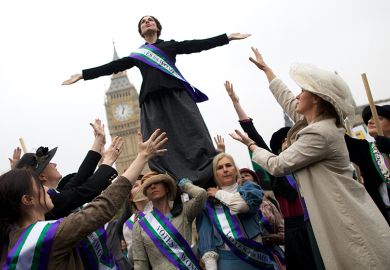If you have a sneaking suspicion that A Century of Women means 100 years and over 700 pages of pure political protest, do not worry. Sheila Rowbotham, a "feminist historian", is far too professional for that. Certainly, feminism in the most political sense of the word features strongly, as it should considering its impact, but Rowbotham offers us a far wider picture - a true history. Women who would not consider themselves feminists, those who were/are opposed to the feminist movement, all find a place in this text. For as Rowbotham rightly says: "The history of women is ... no more cut and dried than the circumstances of women." And so not only do we have here the history of the socialist feminist movement, but also that of the female division of the Ku Klux Klan. Rowbotham's book really brings home how being female could unite those who would usually have been kept apart by class or colour. She also shows how the very same facts could be the cause of alarming splits in women's movements. Consider the Pankhurst family. During the first world war, Sylvia Pankhurst, who viewed it as a "capitalists' war", supported the pacifist Alice Wheeldon, who sheltered conscientious objectors. But Sylvia's mother and sister, Emmeline, and Christabel, disowned Wheeldon, who later died in prison after a hunger strike. Emmeline publicly pledged her support for the government questioning how any woman, "could ... face the possibility of the affairs of the country being settled by ... shirkers."
It is unfortunate that many in the movement criticised one another when there were far more sinister forces to confront such as the antisuffrage lobby, who labelled suffragettes as shrews and hysterics. The Women's Anti-Suffrage Association of Massachusetts's less-than-inspiring message to housewives was: "You do not need a ballot to clean out your sink spout. A handful of potash and some boiling water is quicker and cheaper." Female lobbyists in Britain also highlighted the virtues of the housewife in their bid to discourage suffragettes, yet ironically, "its members did not escape accusation of an unwomanly preoccupation with public affairs".
While all this public debate was taking place, in the 1920s, flappers (so called because they never seemed to keep still) and androgyny became the fashion. Rowbotham discusses how, in this climate, a lesbian identity emerged for the first time, mainly in intellectual circles. Feminist literature of the decade included Dora Russell's The Right to be Happy, which Rowbotham describes as, "an appeal against guilt and repression ... the egalitarian feminist demand for 'the right to do any man's work'".
A decade later, with the outbreak of the second world war, this right became a patriotic duty. There were 12 women MPs in Parliament when war was declared. A Women's Consultative Committee was formed to oversee women's participation in the war and women were soon working alongside men in factories and gasworks. "For some it seemed ... halfway between prison and boarding school, for others it was the luxury of being told to drink a pint of milk a day." Whatever their feelings, wartime employment gave women the opportunity to experience the workplace and a certain amount of autonomy. The new image of women filtered into popular culture with the appearance of Rosie the Riveter, the cartoon cover girl, in the United States Saturday Evening Post in May 1943. Rosie was, says Rowbotham, "a confident, broad-shouldered figure with muscular arms (who) transcends gender". To show the change for women from the ultraconservative 1950s to the swinging 1960s, Rowbotham uses Betty Friedan's The Feminine Mystique. Apparently contented mothers and wives, the feminine ideals, "were turning to drink, tranquillisers and bowling alleys (which provided nurseries)".
The book continues through the 1970s and 1980s discussing burn-your-bra feminism and the power dressers of American TV shows Dallas and Dynasty. Here were women who were ultrafeminine and ultra-autonomous. The sometimes puritanical feminism of the 1970s had been transformed into the "have it all" culture, in which lipstick, eyeliner, a can of hairspray and detachable shoulder pads were a girl's best friends.
Rowbotham's history is such a good read, partly because its sources are diverse enough to include TV shows and magazines, song lyrics and comic strips, as well as the legislation and literature generated by intellectual debate. It is quite a feat for one author to have collected all this material and made it highly readable. I would like to have seen a little more analysis of the feminist backlash of the early 1990s, but no history is all encompassing and on the whole the book is well balanced.
A chronology would have been more useful than the brief biographical dictionary at the end. It would help to structure the incredible amount of information in the book (enough to justify two volumes, one for the UK, one for the US). But this is a minor quibble. As a history, this book more than serves its main purpose, which is to reveal the dilemma faced by women throughout the century: in Crystal Eastman's words, "How to arrange the world so that women can be human beings with a chance to exercise their infinitely varied gifts in infinitely varied ways."
Katrina Wishart is editorial assistant, The THES.
A Century of Women: The History of Women in Britain and the United States
Author - Sheila Rowbotham
ISBN - 0 670 87420 5
Publisher - Viking
Price - £20.00
Pages - 752
Register to continue
Why register?
- Registration is free and only takes a moment
- Once registered, you can read 3 articles a month
- Sign up for our newsletter
Subscribe
Or subscribe for unlimited access to:
- Unlimited access to news, views, insights & reviews
- Digital editions
- Digital access to THE’s university and college rankings analysis
Already registered or a current subscriber?



